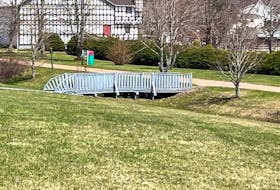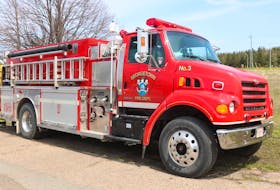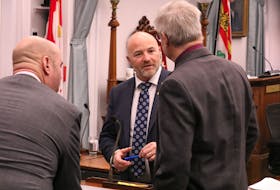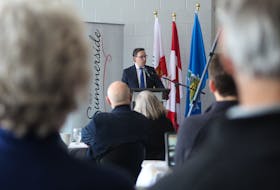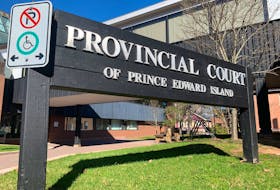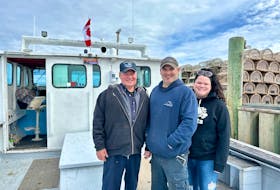
The house was hard to see from the road, but once located, it was not hard to tell that this house was special in some way.
Another passive solar home has been built on Prince Edward Island, and homeowners Tracey and Rev. Stephen Allen were thrilled to open their home recently for a tour.
The home is located on Covehead Road on a beautiful lot behind some trees. The oddly shaped home is a sight to see and the interior of the house is an experience on its own.
Construction began in April and lasted three months and the Allens were able to spend their first night in the house on July 19.
The home is a three-bedroom, single-bath, one-level home. They were advised to rethink putting flooring into the home, so they decided to paint the concrete floors instead. With a marble-like finish, the floors look like a oil-based painting.
When the sun shines in and hits the floors, the concrete will hold the heat. The floors took a couple of days to paint and the Allens did it all themselves.
"It is like we have in-floor heating, and it also releases the heat at night. It adds more character, we did our closet first in case we didn't like it. It works with every room, we saved about $20,000 by not putting flooring in, I could not imagine anything else now that we have it," said Tracey, laughing.
In the laundry room, the Allens have a washing machine but no dryer. Tracey said she hangs all of her laundry to dry.
The heat of a dryer would use up a lot of energy.
Eventually, the family will switch over to a solar hot water boiling system. Right now, they are using electrical.
In the bathroom and hallway, they have two "solar tubes" on the ceilings. The sun shines directly in, and the light it gives off is almost as bright as a regular light bulb, even on a cloudy day.
"On a moonlit night, we still have light," Tracey said.
"It is almost like a skylight but without the heat and the loss of energy and air," Stephen added.
Also in the bathroom, the family installed a European-style shower where there is no door or curtain. It is an open concept the couple fell in love with while visiting Lebanon and Syria.
"The rain shower spout shoots straight down, you use a lot more water in a bath. We have a set tub if we need it," Stephen said.
Tracey said the family lived in Stanhope for nearly 15 years and wanted to stay in the area. They have always been "green" and decided to build a passive solar home for a number of personal reasons.
Danny Rochon, of Yorktown Construction, was the contractor for the build. He explained how the passive solar product, called ICF (insulated concrete form), works.
"The house will hold the heat for a long period of time because of the ICF and the concrete construction. The concrete wall system will absorb and hold the heat so the house will stay warm for about 24 hours before they would really notice it getting cold again," he said.
Even in the winter, as long as the sun is shining in the windows, the concrete floors will absorb the heat.
Because the entire house was constructed out of concrete, the walls have a very tight seal and there is no air penetration, so the house holds the heat.
Tracey said they have a wood stove for backup.
"We have talked to people who have passive solar homes, not ICF but made out of wood, they don't burn any more than two cords a year for wood," Tracey said.
The Island has been getting some extremely warm weather lately, and the Allens had the luxury of relaxing inside their home comfortably.
"We're not cold, we're not hot, we were just right," she said.
Rochon specializes in building passive solar homes using an ICF technology.
"These are very comfortable homes. People go into them and they say they just feel good, and I can't explain why. It could be air quality, people just say they feel different," he said.
The ICF blocks are like hollow Lego blocks, Rochon said. They stack them up for the walls and fill them with concrete, and the time frame for the build is about the same as building a regular wooden home.
"It is a little bit more expensive, about eight to 10 per cent more expensive than building a regular wooden home. You get at least 50 per cent of energy savings, within 10 or 15 years you can pay for the initial investment, you just redirect where your money is going," he said.
Rochon has been building homes for quite some time, and ICF homes for 14 years.
He said he thought it would be a lot quicker for Islanders to catch on to the passive solar systems, but it has not been as popular as he assumed.
The technology for building solar homes has been around for more than 30 years.
"I think this is going to be the future, this is going to be the way," Rochon said.
"It is so much more of a Cadillac as a regular home. There is more and more coming up, most contractors know about it, and they know it is going to be the way of the future. It is pretty known that these homes are efficient."
With their house finally finished and set up, the Allens are living comfortably. Tracey even took the time to write a short book about their experience with building a solar house, and the book is available on Kindle.
Twitter.com/PEIGuardian

